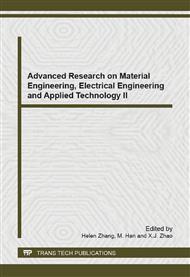[1]
Z.D. Jia, H.F. Gao, Z.C. Guan, L.M. Wang, J. Yang, Study on Hydrophobicity of Transfer of RTV Coatings Based on a Modification of Absorption and Cohesion Theory, IEEE T. Dielect. El. In. 13 (2006) 1317-1324.
DOI: 10.1109/tdei.2006.258203
Google Scholar
[2]
M.E. Ryan, J.L.C. Fonseca, S. Tasker, J.P.S. Badyal, Plasma Polymerization of Sputtered Poly(Tetrafluoroethylene), J. Phys. Chem. 99 (1995) 7060-7064.
DOI: 10.1021/j100018a044
Google Scholar
[3]
J. Hopkins, J.P.S. Badyal: J. Phys. Badyal. Nonequilibrium Glow Discharge Fluorination of Polymer Surfaces, J. Phys. Chem. 99 (1995) 4261-4264.
DOI: 10.1021/j100012a056
Google Scholar
[4]
R.H. Popat, I. Sutherland, E.S. Shang: J. Mater. Vapour-phase Chemical Derivatisation for the Determination of Surface Functional Groups by X-ray Photoelectron Spectroscopy , J. Mater. Chem. 5 (1995) 713-717.
DOI: 10.1039/jm9950500713
Google Scholar
[5]
S.R. Coulson, I.S. Woodward, S.A. Brewer, C. Willis, J.P.S. Badyal, Ultralow Surface Energy Plasma Polymer Films, J. Chem. Mater. 12 (2000) 2031-(2038).
DOI: 10.1021/cm000193p
Google Scholar
[6]
S. Sigurdsson, R. Shishoo, Surface Properties of Polymers Treated with Tetrafluoromethane Plasma , J. Appl. Polym. Sci. 66 (1997) 1591-1601.
DOI: 10.1002/(sici)1097-4628(19971121)66:8<1591::aid-app21>3.0.co;2-5
Google Scholar
[7]
I. Woodward, W.C.E. Schofield, V. Roucoules, J.P.S. Badyal, Super-hydrophobic Surfaces Produced by Plasma Fluorination of Polybutadiene Films, J. Langmuir. 19 (2003) 3432-3438.
DOI: 10.1021/la020427e
Google Scholar
[8]
J. Lee, K. Kim , Y. Lee, Characterization of fluorocarbon thin films deposited by ICP and PP, J. Journal of Surface Analysis. 3 (2011) 269-273.
DOI: 10.1384/jsa.17.269
Google Scholar
[9]
X.D. Chen, D.X. Po, R.H. Sun, Y.J. Hu, J.Q. Wang, Suface Modification of Silicone Rubber to Improve Its Surface Hydrophilicity, J. Polym. Mater. Sci. Eng. 16 (2000) 153-155.
Google Scholar
[10]
J.J. Kennan, Y.A. Peters, D.E. Swarthout, M.J. Owen, A. Namkanisorn, M.K. Chaudhury, Effect of saline exposure on the surface and bulk properties of medical grade silicone elastomers, J. J Biomed Mater Res, 36 (1997) 487–497.
DOI: 10.1002/(sici)1097-4636(19970915)36:4<487::aid-jbm6>3.0.co;2-a
Google Scholar


